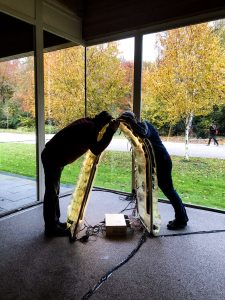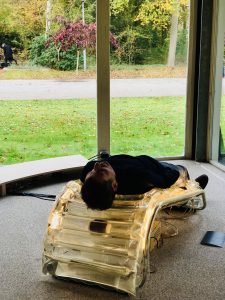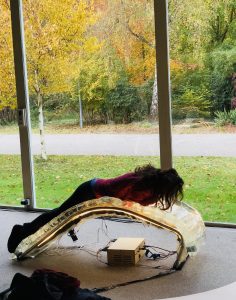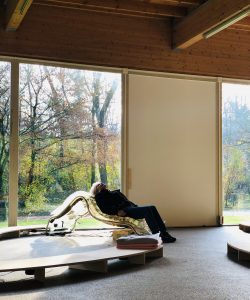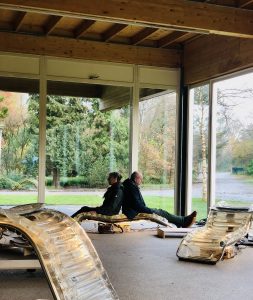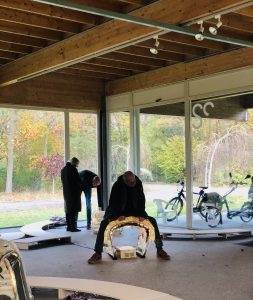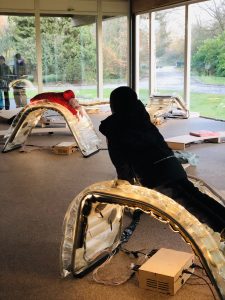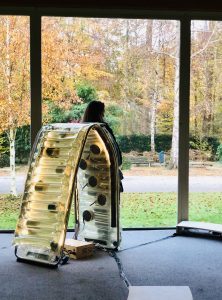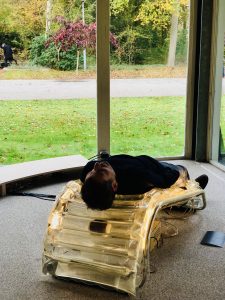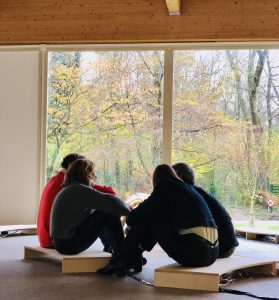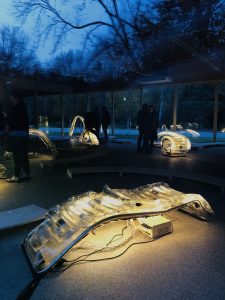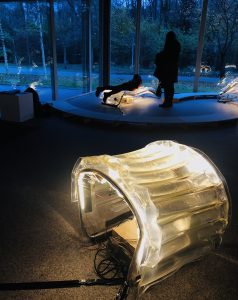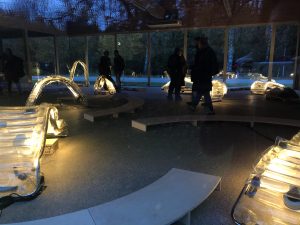Meeting Adi Hollander and Claudio F. Baroni, by Anh Dinh (Zone2Source Communication trainee)
I came to The Body Imitates the Landscape on a Sunday afternoon, joined by dozens of families and other visitors eager to explore the tactile experience. As I watched the visitors interacting with the installation, I had a fascinating insightful chat with visual artist Adi Hollander and the composer Claudio F. Baroni on their project.
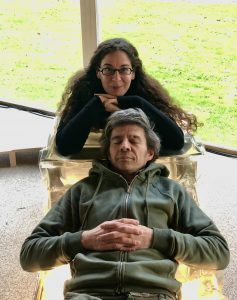
The visual artists Adi Hollander and composer Claudio Baroni collaborated on the tactile sound project.
Hollander explained the work’s starting point was the Japanese book
Karada (Body) by Michitaro Tada, which is a socio-cultural-physical essay on the “School of the Body.” The book inspired them to create a work that generates awareness of the body. In doing so, they translated the textual experience of reading this book into a sensory experience. The book’s structure of 11 chapters is restored as a grid for the musical composition.
The installation consists of the sound composition and over twenty objects across the space. Hollander and Baroni gave themselves certain rules in actualizing the work: to integrate the idea of
play – a space for the audience to break the unspoken rules of “concert” culture, to involve
simultaneous public and private experiences (part of Adi’s ongoing practice developed in the collective Public Space with a Roof
www.pswar.org), and to respond to John’s ideas of the audience’s responsibility. These rules drove the artists to create a “stage” for the audience rather than for the musicians, and to present it as both sound-installation and live-performance. Abandoning the conventional concert stage format, where the public is passively engaged with the work, they built on the idea of a playground with the public as the activators, creating and ruling the space through their interactions with the work. “Your existence and the way you function within that space give life to the work. At the same time, the work gives you the possibility of moving and directing,” said Hollander.
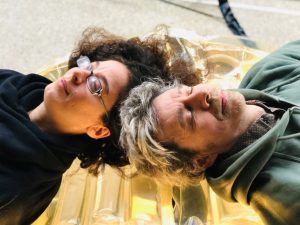
The partners aimed to present listening in a different sense – using your whole body.
Comprising 17 large inflatable modules and 60 small wooden benches with 180 speakers built-in in total, the installation earns a different tactile quality and a different sound timbre from each of its components. The playful inflatable structures and their various shapes invited me to immerse myself in them. Lying down on the comfortable, soft, and warm water mattress covering the object, I felt the sound vibrations running through all my body parts, an effect which Hollander compared to being wrapped by a cloud of sound in a concert hall. Meanwhile, the arrangement of the modules and wooden benches resembles a Japanese Zen garden, which appears intriguing to visitors as for a moment they drifted away into the tactile sounds. According to Hollander, the modules and the wooden benches act as a vantage point from which the audience can experience the work while “becoming one of [its] ‘performers’ and ‘choreographers’.”
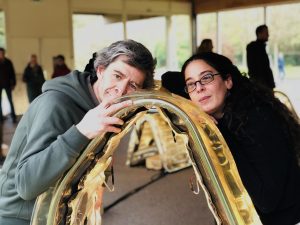
Baroni shared that whispering added secrecy to the tactile game, just like telling a secret in public.
Baroni explained that the music’s essence is a whispering voice, the script for which is based on texts quoted and abstracted from Tada’s book. Perceived much more as noise than as melody, the whispering voice is also called “un-voiced speech” to distinguish it from normal speech. The composition is written to disclose the hidden harmonies existing in normal speech, and to express in the work the tension between the flow of “un-voiced speech” and these sustained harmonies brought to the surface by musical instruments (including flute, bass clarinet, double bass, electric guitar, piano, percussion).
Bringing the Work Home
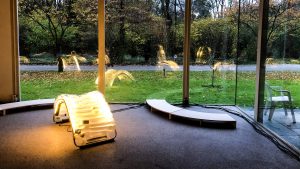
The installation glowing in the dark
The installation came to Zone2Source after being exhibited in three other venues including Dutch Design Week in Eindhoven and November Music in Den Bosch. Both artists saw Zone2Source as the perfect venue. Especially to Hollander, it was like “closing a circle and bringing the work home” – Home in the sense she presented an earlier work in Zone2Source during the group exhibition
Resonant [LINK], that represented the study she conducted for this project, but also home in the sense of being in a space dedicated to visual art instead of venues where the main focus was on design or music.
Both artists cherish the natural backdrop of Amstelpark that enfolds Het Glazen Huis and the lights’ mystical reflection on the glass walls as the night draws in as if the exhibition continues beyond the walls.
No universal approach
The artists’ joint ambition and efforts were well-received by the public during the three weeks their work was on show in Zone2Source. Hundreds of visitors enthusiastically observed the arrangements and felt the vibrations through the beds with their whole body. “Throughout the various venues that held this installation,” Hollander added, “I witnessed no universal approach to the work. Someone would touch the bed with one finger and then leave, others just sat and observed, while some others would rest on and feel the bed the whole day.”
If anything, the public shares the space within the work. This multifaceted public is also what the partners aimed for. While Hollander described it as an inspiration for public debates and exchanges on sensation, Baroni added the exhibition “opens up a new sense of hearing” and leaves the door open for more to be discovered.
You can read more about the ideas and concepts of
The Body Imitates the Landscape including a list of venues where the work will be shown in 2020 via
http://thebody.aholl-studio.org/.
The CD
The Body Imitates the Landscape For tape, transducer speakers & ensemble is composed by Claudio F. Baroni [
https://claudiofbaroni.net/], participated by MAZE ensemble [www.maze.nu], and published by Unsound [www.unsounds.com/shop/catalogue/the-body-imitates-the-landscape]
We also captured many moments of the visitors’ amusement with the installation:
